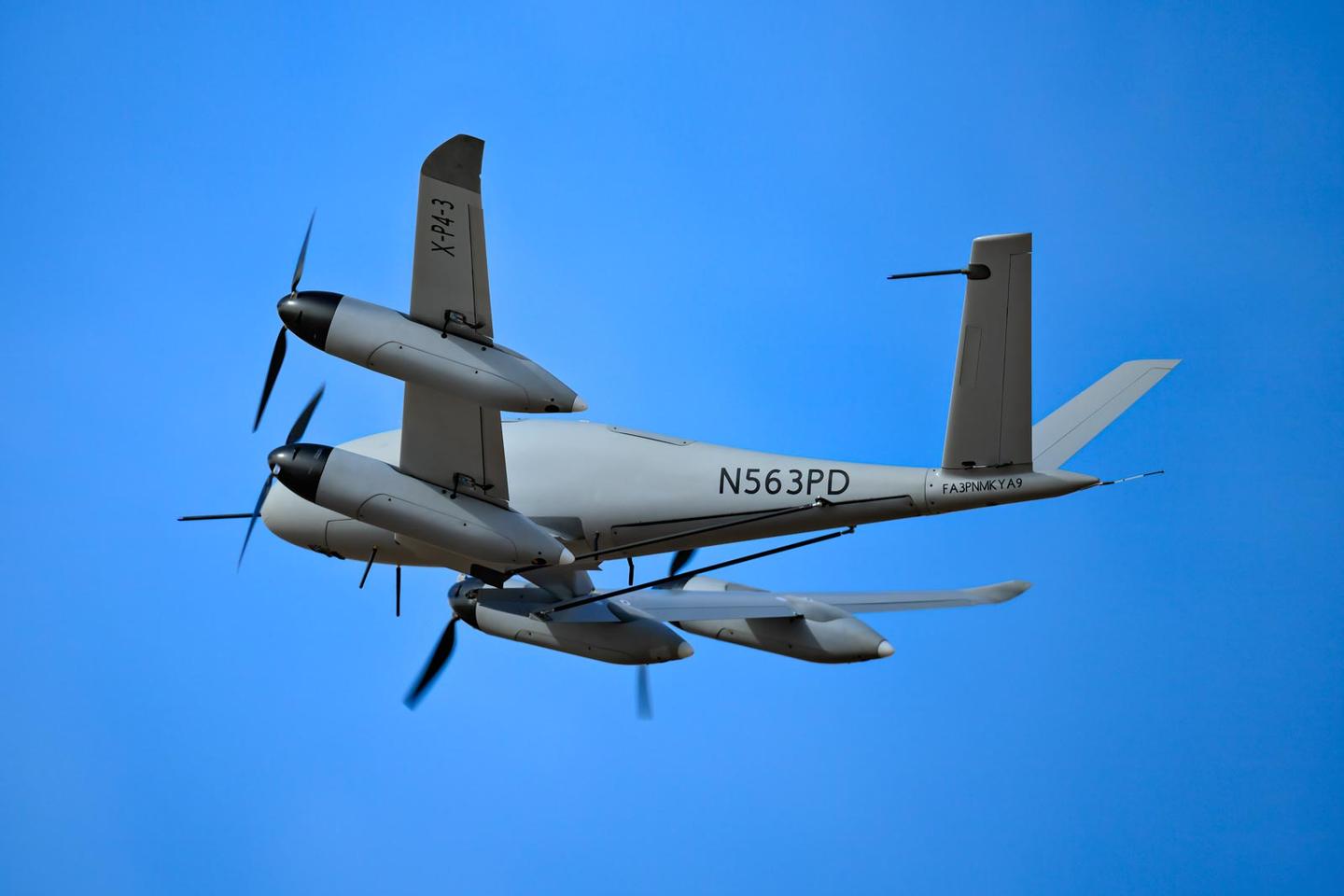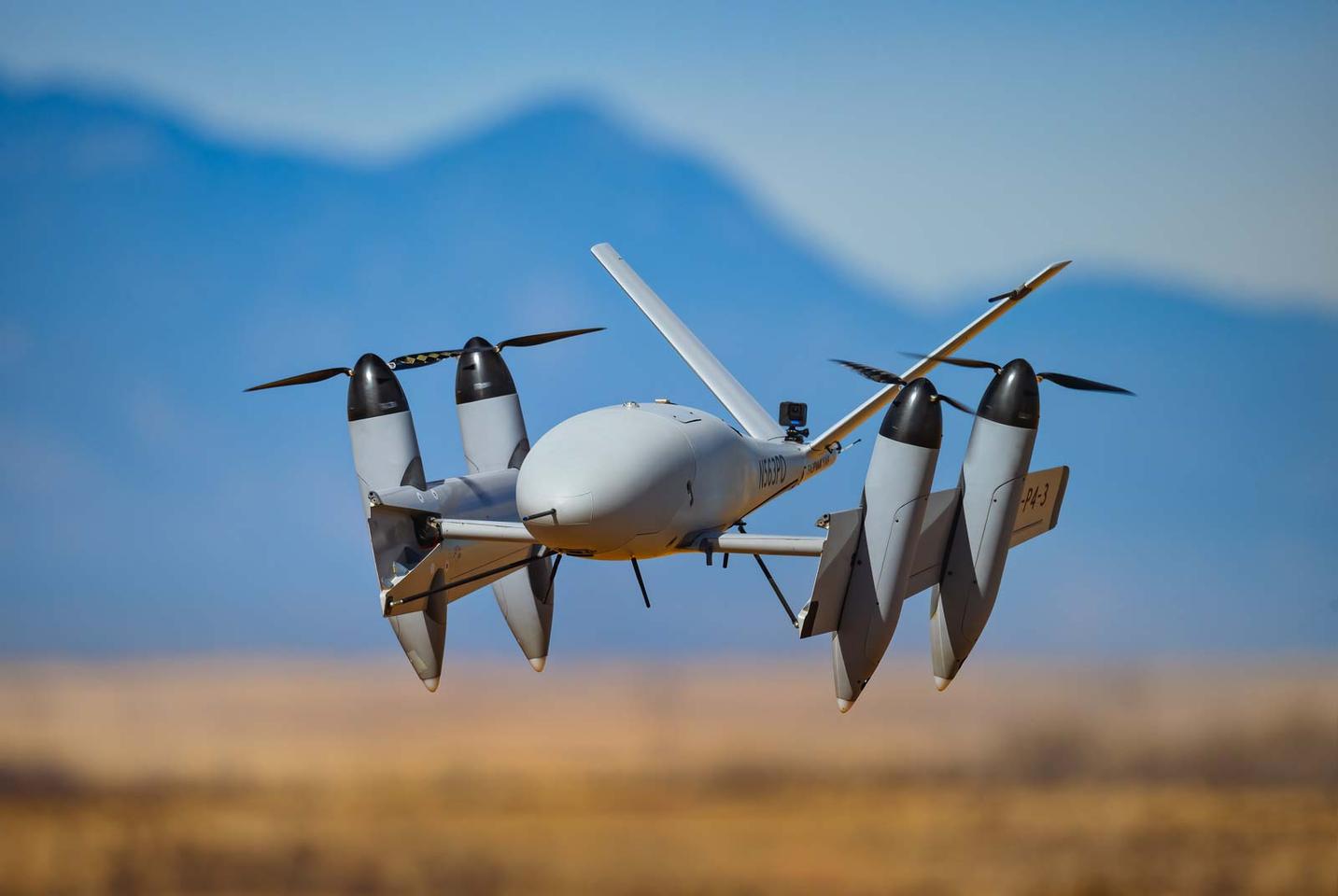Pterodynamics has taken its unique and fascinating Transwing drone out for sea trials with the US Navy, demonstrating its ability to land autonomously on a moving target. Its dihedral folding wings give it exceptional range and cargo capacity.
The Transwing design is a rare bird in aviation – a weird and different approach that actually appears to offer significant benefits with very few drawbacks. At its core, it’s a cruise-capable, transitioning eVTOL airframe – but the way it shape-shifts between hover and cruise modes makes it one of the smartest aircraft we’ve seen.
On dihedral hinges, its wings fold in from fully extended on a horizontal plane to tucked back against its sides on a vertical plane, like a sweep wing crossed with a tilt wing. The four propellers spaced out across the wings are fixed in place, and they rotate from fully horizontal to face vertically upward when the wings are folded in.

Pterodynamics
The result: an aircraft that’s remarkably compact on the ground, but with a huge wingspan in the air. There are none of the additional weight of tilting propulsion systems, or the additional weight and drag of a lift/cruise design whose lift props are useless in cruise mode. Indeed, the back tips of the propulsion nacelles double as landing points, saving the additional weight of legs or landing gear.
This makes it about the lightest, highest-lift and lowest-drag transitioning VTOL airframe design we’ve seen, giving it next-level efficiency that boosts payload capacity and range well beyond what traditional designs can do – with the exception of a large and cumbersome tailsitter. It’s heavier than a fixed-wing plane, but not by much.
It’s also extremely easy to manage; a Transwing aircraft can be boxed or crated up for transport in its compact VTOL mode, ready to fly. You don’t even need to pull the propellers off; the blades fold back in against the nacelles when they’re not rotating, meaning you can cruise on just two props for even greater efficiency and range.

Pterodynamics
Pterodynamics has built a number of prototypes, the current model being the X-P4, with a 13-foot (4-m) wingspan. It’s capable of lifting 15 lb (6.8 kg) of payload at a maximum takeoff weight (MTOW) of 84 lb (38 kg), then covering 69 miles (111 km) of range in an hour of cruise speed before the battery runs out. In a sprint, it can do 115 mph (185 km/h).
It flies autonomously, and in the high wind test video below you can see the Pterodynamics team training it to land on moving targets like the back of a moving truck – handy for military use cases. But its superb range has got the US Navy interested in the Transwing as a ship-to-shore logistics platform, autonomously delivering cargo that might otherwise call for a highly expensive helicopter to be scrambled, pilot and all.
PteroDynamics XP-4 demonstrates high wind test flight.
Hence last week’s demonstration, in which the X-P4 made nine autonomous launch and recovery flights from the deck of the USNS Burlington as it sailed near Key West, Florida, with Vice Chief of Naval Operations Admiral Lisa Franchetti and representatives from the U.S. Navy, the Royal Navy, the Royal Australian Navy, the Royal Netherlands Navy, and the Swedish Navy looking on.
“Participating in The Hybrid Fleet Campaign Event brought us closer to our goal of providing the U.S. Navy with a flexible and scalable shore-to-ship, ship-to-ship, and ship-to-shore automated cargo delivery capability,” said Tim Whitehand, PteroDynamics VP of Engineering. “Flight testing on board the USNS Burlington gave us a unique and valuable opportunity to collect performance data on the Transwing system in an operational environment. The information gathered during the event will accelerate development and seed further innovation. We are grateful for the opportunity to participate in this important exercise and the support of the Naval Air Warfare Center Aircraft Division (NAWCAD) and Naval Air Systems Command (NAVAIR).”
Check out some video of the Navy demo flights below.
Navy flight test with PteroDynamics Transwing®
While the X-P4 is quite a hefty drone, needing two people to carry it, Pterodynamics is planning to go much bigger. The X-P5 will have a 22-ft (6.7-m) wingspan, and it’s designed to carry 50 lb (23 kg) of payload up to 575 miles (925 km) using a hybrid power system. And the X-P6 will take things up another level with a turbogenerator powertrain, carrying 220 lb (100 kg) up to 978 miles (1,574 km) on a 30-ft (9.1-m) wingspan.
Source: Pterodynamics
Source of Article
